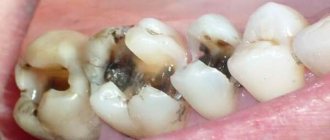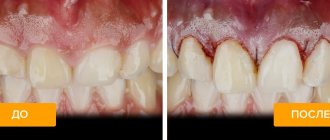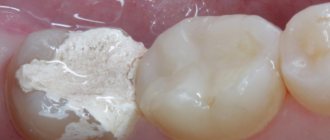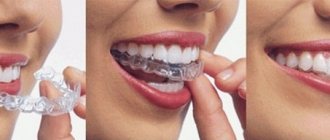It is not always possible to treat a tooth in one visit - if the caries is complicated and the root canals are inflamed, the doctor puts a temporary filling under which he puts medications. It prevents medication from falling out, protects the treated dental cavity from food debris and microbes.
A temporary filling is made of a looser material. It is plastic and does not dissolve in water. For filling, dentin paste, sympath, vinoxol, and zinc-polyacrylate cement are used. The doctor chooses the material, taking into account the diagnosis and the condition of the tooth.
Temporary filling is used for prosthetics, if caries has not reached the nerve, when the nerve is removed. A filling is also installed in the following cases:
- treatment of pulpitis, periodontitis;
- deep caries;
- removal of a tooth root cyst;
- multi-stage therapy;
- making a dental stump inlay when installing a crown.
The period of wearing a temporary filling usually does not exceed 1-1.5 weeks, but sometimes it can be extended up to six months. The dentist determines it exactly.
Sometimes, after installing a temporary filling, patients complain of discomfort and pain. Why does pain occur, how to deal with it?
Why does a tooth hurt after installing a temporary filling?
Pain and discomfort can be a normal reaction, which occurs in 60% of patients, but sometimes pain indicates pathology, inflammation, and complications. After filling, you need to listen to your feelings; if your condition worsens, be sure to consult a doctor.
Installing a temporary filling may cause pain due to treatment and tooth preparation. Natural causes of pain:
- irritation, tooth trauma during cavity treatment, drug installation;
- the effect of medications on the dental pulp;
- the effect of necrotizing agents on the nerve, pulp until the death of nerve endings;
- increased tooth sensitivity, exposure to cold or hot food.
Temporary pain occurs in the first few days after treatment, it is short-lived, the intensity of the sensation gradually decreases, the tooth “aches”, but without excessively painful sensations. How long a tooth hurts after installing a temporary filling depends on the disease: during the treatment of caries it may not appear, but with pulpitis it goes away within one to two weeks. Dental gels and special pastes that reduce tooth sensitivity will help alleviate the condition.
Sometimes, under a temporary filling, severe tearing pain occurs, which intensifies at night. If such sensations are accompanied by other symptoms - swelling of the cheek or gums, numbness of the jaw, increased temperature, this indicates the development of complications. In this case, you need to consult a doctor as soon as possible.
What could be the reason?
1. Individual reaction of the body to root canal treatment,
2. Inaccuracies in medical work.
And if your body’s physiological response to medical intervention is almost impossible to predict, all that remains is to focus on reducing potential risks during root canal treatment.
High-quality root canal treatment – what is it?
Yes, endodontic treatment (root canal treatment) is a rather complex dental procedure. To perform it well, you need precise manual skills of a doctor, an understanding of the mechanisms of pulpitis and periodontitis, and most importantly, compliance with protocols and treatment techniques.
Causes of pain after root canal filling
Principle No. 1 - sterility
One of the key principles in root canal treatment is to achieve relative sterility in the tooth canals. There is no way to completely get rid of microorganisms, but a doctor is quite capable of reducing the number of bacteria to the minimum level that the immune system can cope with.
To ensure sterility in the root canals, the dentist uses a rubber dam, this is a special latex scarf. Using a rubber dam, the doctor isolates the desired tooth from the rest of the mouth, which prevents saliva and bacteria from entering the root canals.
And to destroy bacteria that are already inside the root canals, the dentist repeatedly rinses the canals with sodium hypochlorite.
Principle No. 2 – full channel processing
In order to seal the canals and even to thoroughly rinse them with an antiseptic solution, you must first go through each canal for its entire length. Then, give the channels the required shape and expand them to the optimal size. For this purpose, the dentist-therapist has special tools in his arsenal, similar to thin flexible needles. They can be manual or machine. The best result is obtained by their combination.
Principles in root canal treatment
When treating root canals, KANO clinics use the X-SMART Plus endodontic micromotor and the Endo-Mate TC2 endodontic micromotor. This helps the doctor to process the canals quickly and reliably - because sodium hypochlorite does not get into the under-expanded root canals and bacteria can remain there. A tooth full of microorganisms is doomed to bother you again over time - and even cause removal with subsequent implantation.
Principle No. 3 – control of treatment at all stages
When performing root canal treatment, the dentist can only see the mouth - the very beginning of the root canal. And the rest of the canals are hidden from view inside the tooth root. Therefore, visualization tools play a special role in endotherapy: an X-ray machine and an apex locator.
1. X-ray control should be carried out before, after and during root canal treatment. Don't worry - you won't receive excessive radiation exposure, because during targeted images the radiation dose is very small (1.5-3.3 mSv).
2. Use of an apex locator - a special device for determining the length of the root canal during treatment. This allows the dentist to work only in the dental canal, without going into the peri-root tissue, and to minimize the patient’s pain - both during and after treatment.
Tooth hurts after root canal filling: what not to do
If the doctor controls the canal treatment process and does not work blindly, then the likelihood of post-filling pain is reduced significantly.
What not to do if your tooth hurts after root canal filling:
- Do not heat the tooth or steam it with hot water.
- You cannot cool an aching tooth or keep ice near it.
- Do not apply propolis, cotton wool soaked in essential oils, valocordin or any other substance to the tooth. Unfortunately, you can read about such methods on the Internet, but you absolutely cannot do this: at best there will be no effect, and at worst, you will have a burn to the mucous membrane.
- You should not try to open a temporary or permanent filling yourself.
Tooth hurts after root canal filling: what to do
Possible complications after installing a temporary filling
Pathological processes or complications during treatment can arise due to an allergic reaction of the body, an incorrectly chosen treatment strategy, non-compliance with the period of wearing a temporary filling, or due to loss of medication.
- If the installation of a temporary filling was carried out after placing the drug in the tooth canal, pain may be a sign of an allergy, incorrect dosage of the drug, or incorrectly selected time of exposure. In case of allergies, the doctor replaces the cementing composition or medication.
- If the filling hurts when pressed, this indicates that the periodontal tissue is damaged.
- “Shooting” sharp pain is a sign of purulent pulpitis or tissue inflammation.
- If the pain occurs upon touching and is acute, there may be a piece of dental instrument left in the root canal. The cause of such sensations is also periodontitis.
- Night pain occurs with pulpitis.
Installation of a temporary filling is one of the stages of treatment, and not full-fledged therapy. Over time, such filling material falls out, food and microbes enter the tooth cavity, which leads to a worsening of the condition and the development of complications. In advanced cases, incomplete therapy can cause tooth loss.
Why does pain occur after nerve removal?
When the procedure is performed correctly by a qualified specialist, the patient does not feel severe pain. A little discomfort and slight pain when pressing is quite normal, since there was an intervention in the structure of the tissues, part of them was removed, and the integrity of the blood vessels and nerve fibers was damaged.
But sometimes the tooth hurts after removal of the nerve for more than 2-3 days, the intensity of the pain increases. This happens for the following reasons:
- The nerve was not completely removed; part of it remained in the tooth cavity. Residual pulpitis develops, that is, repeated inflammation due to necrosis of the remnants of nervous tissue. At first, the pain is aching, but over time it becomes sharp and throbbing, as inflammation covers neighboring tissues.
- The soft tissues of the oral cavity are injured, and inflammation of the gum tissue develops.
- The pain is localized in the adjacent tooth and radiates to the treated tooth.
- Depulpation was carried out poorly. For example, the filling material is excessively extended beyond the top of the tooth or the root canal is perforated with an instrument. Sometimes a medical instrument may break, leaving a piece of it inside the canal.
If you have an allergic reaction to the components of the filling material, the pain may be accompanied by a rash and itching. If severe pain occurs when biting or pressing, this indicates trigeminal neuralgia. The rest of the time, the pain due to neuralgia is aching, and the patient experiences difficulty speaking.
Symptoms that indicate the occurrence of pathology:
- there is a constant aching pain;
- it gradually intensifies;
- the area around the tooth is red and swollen;
- there is severe pain and discomfort in the jaw and cheek;
- the pain intensifies when pressed or consumed hot or cold.
If at least one of these symptoms occurs, you should immediately consult a dentist.
What to do if your tooth hurts
Discomfort and pain in the first days after the procedure are normal. If pain persists, you should consult a doctor. He will perform diagnostics and give recommendations.
If it is impossible to see a dentist, the following measures will help alleviate the condition:
- taking analgesics - Ketorola, Naiza, Analgin: these medications will relieve pain;
- rinsing the mouth with herbal infusions based on chamomile, sage, eucalyptus: the plant material is poured with boiling water, left for about an hour, cooled and filtered;
- rinsing the mouth with a solution of soda and salt;
- you can make a lotion from valerian infusion: soak a cotton swab in the infusion, apply to the gum next to the damaged area;
- if swelling has developed as a result of inflammation, antihistamines will help reduce it;
- Gels containing painkillers will help eliminate discomfort.
Important: these are temporary measures designed to alleviate the condition, and not an alternative to going to the doctor. Visit your dentist as soon as possible!
When to see a doctor
If a tooth under a temporary filling constantly hurts, and the pain is bursting in nature and intensifies at night or during the day, you need to consult a dentist as soon as possible. The doctor examines the damaged tooth: if the filling has fallen out, he will put a new one and replace the medication. If the pain is caused by the development of inflammation or infection, the dentist will take action and change the treatment strategy.
You should immediately consult a doctor in the following cases:
- pain is accompanied by a feeling of swelling of soft tissues;
- the gums or cheek turn red, swell, and swelling appears;
- body temperature rises;
- the intensity of pain does not decrease within several days;
- when exposed to high or low temperatures, the pain intensifies;
- signs of general intoxication of the body develop;
- lymph nodes (primarily submandibular) enlarge and become painful on palpation;
- there is an unpleasant odor from the mouth;
- The temporary filling falls out, its tightness is compromised: cracks and chips form in the cementing material.
In such cases, the dentist will open the filling, remove the medicine and any remaining filling material. The doctor will disinfect the hole, clean and dry the root canals. If necessary, seal them with sealer and install a pin. After such treatment, an x-ray is performed - it allows you to evaluate the quality of treatment. Next, the dentist can re-install a temporary filling or change therapeutic methods.
How to relieve pain?
If you followed all the doctor’s recommendations, but the tooth under the temporary filling hurts again, the following tips may help you:
- avoid contact of food and drinks, especially very hot or cold ones, on the side of the diseased tooth;
- periodically rinse your mouth with soothing infusions of sage, chamomile and mint and a disinfectant solution of salt and soda;
- Inspect the soft tissue surrounding the tooth as often as possible in order to identify the possible onset of an inflammatory process or suppuration. At the slightest hint of swelling or redness of the gums, call your dentist immediately;
- a cotton wool soaked in tincture of valerian and lemon balm and applied to a sore tooth will help temporarily relieve irritation and soothe pain;
- There are also special preparations (drops, gels) designed to relieve toothache, however, before using them, you should consult a specialist.
If your dentist feels there is no cause for concern, try to endure the painful period so as not to interrupt the treatment process. Unfortunately, any inflammatory process is accompanied by unpleasant sensations. It’s better to have pain under a temporary filling than to have to redo a permanent one later.











